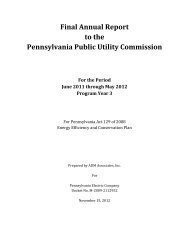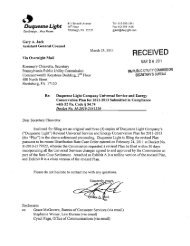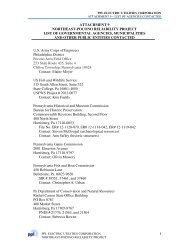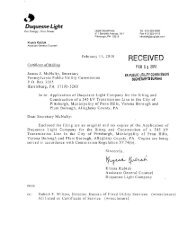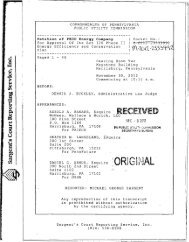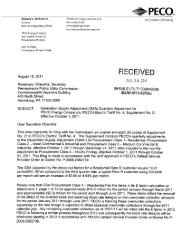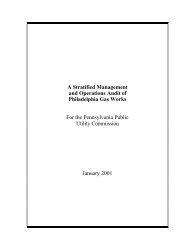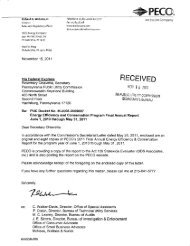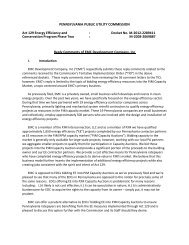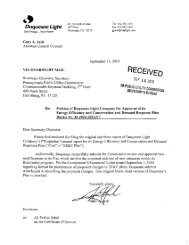Electric Power Outlook - Pennsylvania Public Utility Commission
Electric Power Outlook - Pennsylvania Public Utility Commission
Electric Power Outlook - Pennsylvania Public Utility Commission
You also want an ePaper? Increase the reach of your titles
YUMPU automatically turns print PDFs into web optimized ePapers that Google loves.
PPL <strong>Electric</strong> Utilities Corporation<br />
PPL <strong>Electric</strong> Utilities Corporation (PPL), a<br />
subsidiary of PPL Corporation, provides service to<br />
1,401,274 homes and businesses over a 10,000-<br />
square-mile area in all or portions of 29 counties in<br />
Central Eastern <strong>Pennsylvania</strong>. In 2010, PPL had<br />
energy sales totaling 36,919 GWh—down 1.9<br />
percent from 2009. Residential sales continued to<br />
dominate PPL's market with 38.5 percent of the total sales, followed by industrial (32.6 percent)<br />
and commercial (28.9 percent). These figures reflect a reclassification of commercial and<br />
industrial (C&I) customers; i.e., the commercial class now includes small C&I (non-residential<br />
secondary voltage), and the industrial class includes large C&I (primary and transmission voltage).<br />
Average annual use per residential customer was 11,666 kWh at an average cost of 10.27 cents per<br />
kWh; operating revenues totaled $2.5 billion.<br />
The current five-year projection of average growth in energy demand is 0.9 percent. This includes<br />
growth rates of 0.2 percent for residential, 1.5 percent for commercial and 1.0 percent for<br />
industrial, based on the redefined rate groups. See Figure 21.<br />
PPL's summer peak load, occurring on July 7, 2010, was 7,214 MW compared to the previous<br />
summer’s peak of 6,845 MW, or a 5.4 percent increase. The 2010-11 winter peak load was 7,365<br />
MW, representing an increase of 8.3 percent from last year's winter peak of 6,800 MW. The actual<br />
average annual peak load growth rate over the past 15 years was 0.7 percent. PPL’s five-year<br />
winter peak load forecast scenario shows the peak load decreasing from 7,365 MW in 2010 to<br />
7,101 MW in 2011 and then increasing to 7,282 MW in 2015 at an average annual rate of 0.5<br />
percent. The current forecast for 2011 is 126 MW or 1.7 percent lower than the previous forecast.<br />
It is noted that PPL is normally winter peaking, but in some years the summer peak has exceeded<br />
the previous winter peak; the current forecast represents the annual peak load. See Figure 22.<br />
Tables A17-A20 in Appendix A provide PPL’s forecasts of peak load and residential, commercial<br />
and industrial energy demand, filed with the <strong>Commission</strong> in years 2001 through 2011.<br />
In 2010, PPL purchased 63 GWh from cogeneration and independent power production facilities,<br />
or 0.2 percent of net energy for load.<br />
For Calendar Year 2010, 45 EGSs supplied 23.7 GWh to retail customers in PPL’s service<br />
territory, representing 64.3 percent of total consumption.<br />
PPL has identified several transmission projects, including new construction and rebuilding of<br />
existing lines, with in-service dates through 2020. The projects involve 796 circuit miles at a total<br />
cost of $1.14 billion. The single largest project is the Susquehanna-Roseland Project, described in<br />
Section 1.<br />
<strong>Electric</strong> <strong>Power</strong> <strong>Outlook</strong> for <strong>Pennsylvania</strong> 2010-15 35




